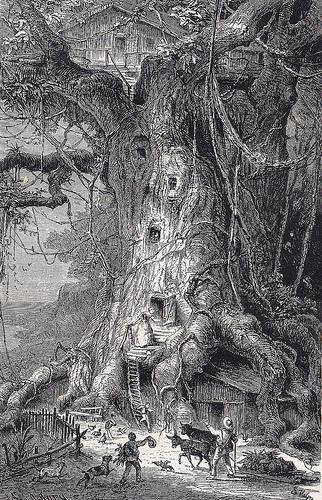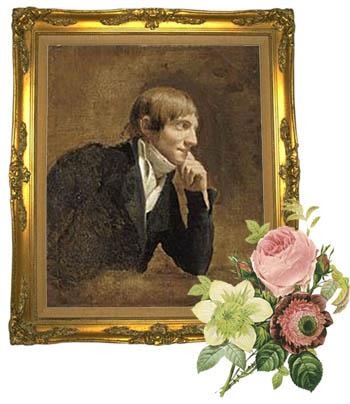
The Swiss Family Robinson: "One of the most popular novels of all time"
 The Swiss Family Robinson: "One of the most popular novels of all time"
The Swiss Family Robinson: "One of the most popular novels of all time"
Johann David Wyss (28 May 1743 – 11 January 1818) is best remembered for his book The Swiss Family Robinson (Der schweizerische Robinson). It is said that he was inspired by Daniel Defoe's Robinson Crusoe, but wanted to write a story from which his own children would learn, as the father in the story taught important lessons to his children. As a pastor, Wyss hoped to teach his sons family values, good husbandry, the uses of the natural world and self-reliance. Wyss' attitude toward education is in line with the teachings of Jean-Jacques Rousseau, and many of the episodes have to do with Christian-oriented moral lessons such as frugality, husbandry, acceptance, cooperation, etc. The adventures are presented as a series of lessons in natural history and the physical sciences, and resemble other, similar educational books for children in this period, such as Charlotte Turner Smith's Rural Walks: in Dialogues intended for the use of Young Persons (1795), Rambles Further: A continuation of Rural Walks (1796), A Natural History of Birds, intended chiefly for young persons (1807). But the novel differs in that it is modeled on Defoe's Robinson Crusoe, a genuine adventure story, and presents a geographically impossible array of mammals, birds, reptiles, and plants (including the bamboos, cassavas, cinnamon trees, coconut palm trees, fir trees, flax, Myrica cerifera, rice, rubber plant potatoes, sago palms, and an entirely fictitious kind of sugarcane) that probably could never have existed together on a single island for the children's edification, nourishment, clothing and convenience. 
Over the years there have been many versions of the story with episodes added, changed, or deleted. Perhaps the best-known English version is by William H. G. Kingston, first published in 1879. It is based on Isabelle de Montolieu's 1813 French adaptation and 1824 continuation (from chapter 37) Le Robinson suisse, ou, Journal d'un père de famille, naufragé avec ses enfants in which were added further adventures of Fritz, Franz, Ernest, and Jack.[1] Other English editions that claim to include the whole of the Wyss-Montolieu narrative are by W. H. Davenport Adams (1869–1910) and Mrs H. B. Paull (1879). As Carpenter and Prichard write in The Oxford Companion to Children's Literature (Oxford, 1995), "with all the expansions and contractions over the past two centuries (this includes a long history of abridgments, condensations, Christianizing, and Disney products), Wyss's original narrative has long since been obscured." The closest English translation to the original is William Godwin's 1816 translation, reprinted by Penguin Classics.

Although movie and TV adaptations typically name the family "Robinson", it is not a Swiss name; the "Robinson" of the title refers to Robinson Crusoe. The German name translates as the Swiss Robinson, and identifies the novel as belonging to the Robinsonade genre, rather than as a story about a family named Robinson. The novel opens with the family in the hold of a sailing ship, weathering a great storm. Only the family is saved when the vessel breaks apart on a reef and the crew and other passengers jump into lifeboats without waiting for the little family to join them. As the ship tosses about, the father prays that God will spare them. There is plenty of food on board, and after they eat, the boys go to sleep, leaving the father and the mother to guard them. 
The ship survives the night, and the family finds themselves within sight of a tropical island. The next morning, they decide to get to the island they can see beyond the reef. With much effort, they construct a vessel out of tubs. After they fill the tubs with food and ammunition and all other articles of value they can safely carry, they row toward the island. Two dogs from the ship swim beside them, and the boys are glad they will have pets when they reach their new home. The ship's cargo of livestock, dogs, guns & powder, carpentry tools, books, a disassembled pinnace, and provisions have survived.

Their first task on reaching the island is to erect a tent of sailcloth they brought from the ship. They gather moss and dry it so that they will have some protection from the ground when they sleep. They are able to find a lobster and to shoot some game, thus to add fresh food to their supplies. Since they have no utensils for eating, they use shells for spoons, all dipping out of the iron kettle that they brought from the ship. They released some geese and pigeons while they were still on the ship and brought two hens and two cocks with them. The father knows that they must prepare for a long time on the island, and his thoughts are as much on provisions for the future as for their immediate wants. The father and Fritz, the oldest son, spend the next day exploring the island. The family spends the next few days securing themselves against hunger. The father and Fritz make several trips to the ship in their efforts to bring ashore everything that they can possibly use. The domesticated animals on the ship are towed back to the island. There is also a great store of firearms and ammunition, hammocks for sleeping, carpenter’s tools, lumber, cooking utensils, silverware, and dishes. 
While the father and Fritz are salvaging these supplies, the mother and the younger boys are working on the shore, sowing seeds, examining the contents of the kegs that floated to shore, and in every way possible making the tent a more livable home. The mother and boys also explore the island to find a spot for a more permanent home. When the father and Fritz can join them, the whole family helps to construct a tree house. The book covers two years. The father and older boys explore various environments about the island. At the end, the father wonders if they will ever again see the rest of humanity. A few years later, an European ship is driven onto their island. The captain is given the journal containing the story of their life on the island. The captain is unable to return to the island because of a storm. He returns to Europe, where the story is published. The family continue to live tranquilly on their island. 
The Swiss Family Robinson was first published in 1812 and translated into English two years later. It has since become one of the most popular books of all time. It was originally illustrated by his son, Johann Emmanuel Wyss. The book was edited by another son, Johann Rudolph Wyss (4 March 1782 – 21 March 1830), an author, writer, and folklorist. In 1805 he became Professor of Philosophy at Bern's academy, and later chief librarian of its city library; in 1811, he wrote the words to the former Swiss national anthem Rufst Du, mein Vaterland . He died in Bern, in 1830, at the young age of 48. Unlike this son, Johann David Wyss lived up to the age of 74, dying in 1818, six years after publishing The Swiss Family Robinson. Wyss has been described as an author whose style was "firmly Christian and moral in tone". Jules Verne declared that The Swiss Family Robinson was one of his favorite books. He liked it so much, that he decided to write a sequel entitled The Castaways of the Flag, many years after Wyss's death.



Leave a comment
This site is protected by reCAPTCHA and the Google Privacy Policy and Terms of Service apply.